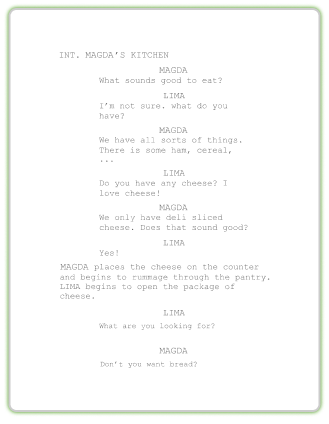With one click
Export a perfectly formatted traditional script.
There are SO many ways to tell a story, but most writers get into a groove on their art forms of choice and stick with it. From novels to web series and screenplays to comic books, writers need to ask themselves what medium works best to get their idea across. But I'd encourage every writer to also try separate mediums than their storytelling platform of choice once in a while. It will help you grow as a creator, reveal new angles that you didn't see before, and you may even find a new favorite way to express yourself! One of those options is through graphic novel storytelling, and for screenwriters, there are four very good reasons why you should consider writing your next story in this medium.
Export a perfectly formatted traditional script.


To make that argument, we brought in script coordinator, TV writer, comic book writer, and graphic novelist Marc Gaffen. He's used his storytelling talents for a multitude of entertainment industry jobs over the years, writing for TV shows including NBC's "New Amsterdam" and "Grimm" as well as the "Grimm" comic book series, script coordinating on shows such as ABC's "Lost" and HBO's "Mare of Easttown," and writing and publishing the graphic novel "Tuskers." He is currently in production on a second graphic novel project.
As someone who's done a little bit of everything when it comes to testing storytelling mediums, he makes a compelling case for why screenwriters should first test their story ideas through graphic novels. But first, some need-to-know info on this storytelling format:
A graphic novel, also known as a comic book or manga (specifically a style of Japanese comic books and graphic novels), is an illustrated story that uses sequential art to tell its narrative. The term "graphic" refers to the use of pictures rather than words in conveying information and ideas. A graphic novel can be any length, from one chapter to several hundred pages long. It may contain only text with illustrations, or it may have both text and images on each page. Graphic novels can also be used for just about any genre, including science-fiction, mystery, horror, and more. You can even find nonfiction graphic novels, like those of Scott McCloud on the topic of comic theory.
Not all comic books are graphic novels, but all graphic novels are variations of a comic book.
Graphic novels are usually longer than the average comic strips and often have more complex plots with multiple characters or settings. They may also be illustrated in full color instead of black-and-white like most comics. The term "graphic novel" was popularized by Will Eisner as an alternative for his own title, "A Contract with God."
Some critics have argued that the term "graphic novel" should be reserved for novels with illustrations; others argue it can also refer to any work containing visual elements. Most agree that a graphic novel needs a complete storyline with a beginning, middle, and end.
According to FamousAuthors.org, these are the best graphic novels of all time:
Perhaps you noticed what many of these titles have in common? Several have been adapted into very successful movies or TV shows. And THAT, Marc tells us, is one of the four perks of writing a graphic novel as a screenwriter.
"Right now, I'm really in love with writing graphic novels because that's something that you're basically in charge. You're the writer and the producer and the director all at once. Basically, you're creating the world, you're creating the action and the dialogue that the characters in your story are doing, and you're working with the artist to figure out the best angles and the best way to implement your vision."
"I'm kind of interesting because I love to have my hands in it all. I love producing, physical production, and I also love creating writing. It's really such a hands-on, every-facet way of telling a story. I published a graphic novel called "Tuskers" about a herd of orphaned African elephants that fight back against poachers. Right now, I'm working on another original graphic novel, and it's really so immersive, it's so much fun to create those types of worlds."
"At the end of the day, the content I create for the graphic novel is mine that I own, which is amazing. Because writing for TV is fantastic, but you are a hired gun. You don't own the content that you create for those TV shows. So, an original graphic novel that you publish on your own, you create all that stuff."
"You can then pitch it to agents and companies to hopefully make a movie or a TV show out of those graphic novels, which is a big thing that's happening right now in the business."
The beauty of comics is that you don't have to leave visuals up to the imagination of the producer or executive that you're pitching.
Other comic book adaptations and graphic novel adaptations include Bong Joon-ho's "Snowpiercer," which he adapted from the French graphic novel "Le Transperceneige." Marielle Heller wrote and directed the film "Diary of a Teenage Girl," adapted from a hybrid graphic novel by Phoebe Gloeckner. And David Selff wrote the adapted screenplay for the Oscar-winning "Road to Perdition" based on the graphic novel of the same name written by Max Allan Collins and illustrated by Richard Piers Rayner. And I'd be remiss if I didn't mention the massive popularity of DC Comics and Marvel.
"I do want to continue [TV] writing, and when the opportunities come, I go for it," Marc concluded. “I've already written an episode of "New Amsterdam," and hopefully, I'll get a chance to be able to do more." But in the meantime, writers can take matters into their own hands by giving graphic novels a go.
If all else fails, self-publish. There's a huge audience for this byproduct of comic books, like a $7 billion market.
That's billion with a B,